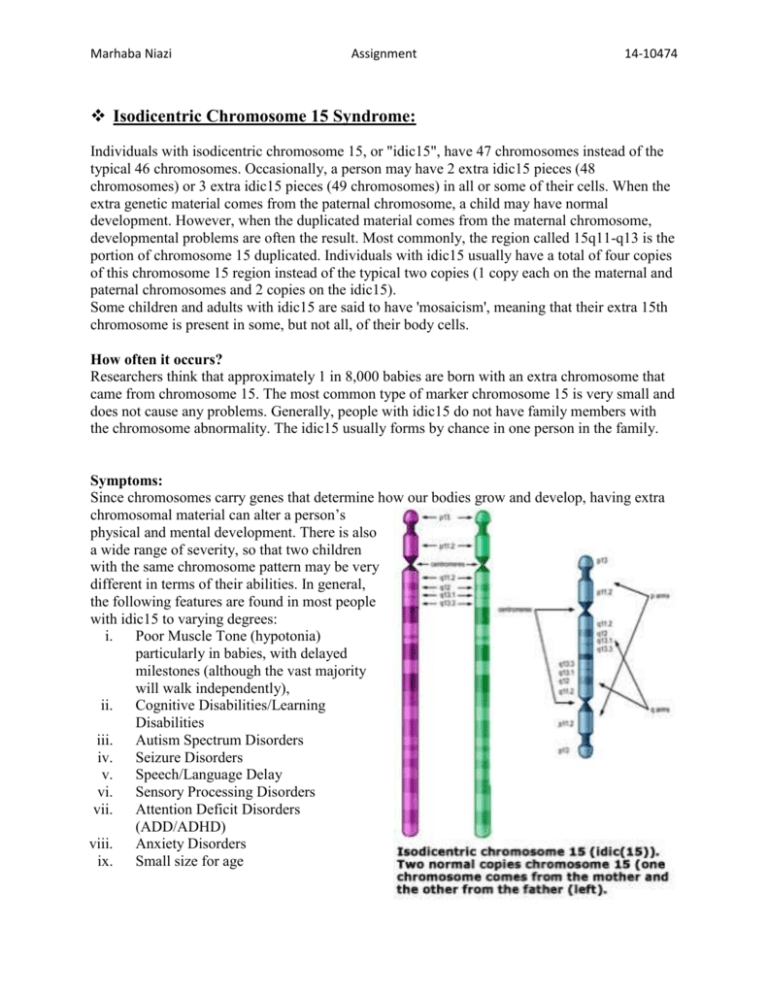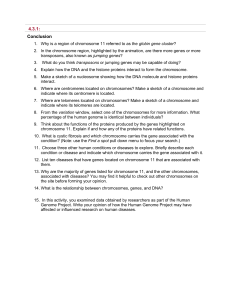How common is isodicentric chromosome 15 syndrome?
advertisement

Marhaba Niazi Assignment 14-10474 Isodicentric Chromosome 15 Syndrome: Individuals with isodicentric chromosome 15, or "idic15", have 47 chromosomes instead of the typical 46 chromosomes. Occasionally, a person may have 2 extra idic15 pieces (48 chromosomes) or 3 extra idic15 pieces (49 chromosomes) in all or some of their cells. When the extra genetic material comes from the paternal chromosome, a child may have normal development. However, when the duplicated material comes from the maternal chromosome, developmental problems are often the result. Most commonly, the region called 15q11-q13 is the portion of chromosome 15 duplicated. Individuals with idic15 usually have a total of four copies of this chromosome 15 region instead of the typical two copies (1 copy each on the maternal and paternal chromosomes and 2 copies on the idic15). Some children and adults with idic15 are said to have 'mosaicism', meaning that their extra 15th chromosome is present in some, but not all, of their body cells. How often it occurs? Researchers think that approximately 1 in 8,000 babies are born with an extra chromosome that came from chromosome 15. The most common type of marker chromosome 15 is very small and does not cause any problems. Generally, people with idic15 do not have family members with the chromosome abnormality. The idic15 usually forms by chance in one person in the family. Symptoms: Since chromosomes carry genes that determine how our bodies grow and develop, having extra chromosomal material can alter a person’s physical and mental development. There is also a wide range of severity, so that two children with the same chromosome pattern may be very different in terms of their abilities. In general, the following features are found in most people with idic15 to varying degrees: i. Poor Muscle Tone (hypotonia) particularly in babies, with delayed milestones (although the vast majority will walk independently), ii. Cognitive Disabilities/Learning Disabilities iii. Autism Spectrum Disorders iv. Seizure Disorders v. Speech/Language Delay vi. Sensory Processing Disorders vii. Attention Deficit Disorders (ADD/ADHD) viii. Anxiety Disorders ix. Small size for age Marhaba Niazi x. Assignment 14-10474 Minor unusual physical features, including wide-spaced eyes with skin folds at the inner corners (epicanthal folds); noticeable unfolding of the edge of the ears; short, upturned nose with a low or flattened nasal bridge; and full lips. Isodicentric Chromosome 15 and Autism Research studies of individuals without chromosome anomalies also support this idea that an autism-related gene may be present in 15q11-q13. Specifically, research studies found that certain DNA markers from the 15q11-q13 region were found more often in individuals with autism than in individuals without autism. Although these DNA markers are too small to be genes, they suggest that researchers may be getting close to finding an autism gene in this region. Researchers are currently focusing on genes in this region called the GABA receptor genes, known as GABRB3, GABRA5, and GABRG3. They are good candidates for being related to autism not just because of their location, but also because of their function. The GABA genes make proteins that carry messages between nerve cells. Several studies have found associations between GABRB3 and autism1 . How common is isodicentric chromosome 15 syndrome? This syndrome occurs in about 1 in 30,000 newborns. Can it be inherited? It is not inherited usually and occurs as a random event in the production of reproductive cells of one of the parents of the effected individual. Diagnosis: Karyotyping is used for the testing and FISH is used for the confirmation of diagnosis for this chromosomal abnormality. 1 Buxbaum et al., 2002; Shao et al., 2003; Cook et al., 1998.








